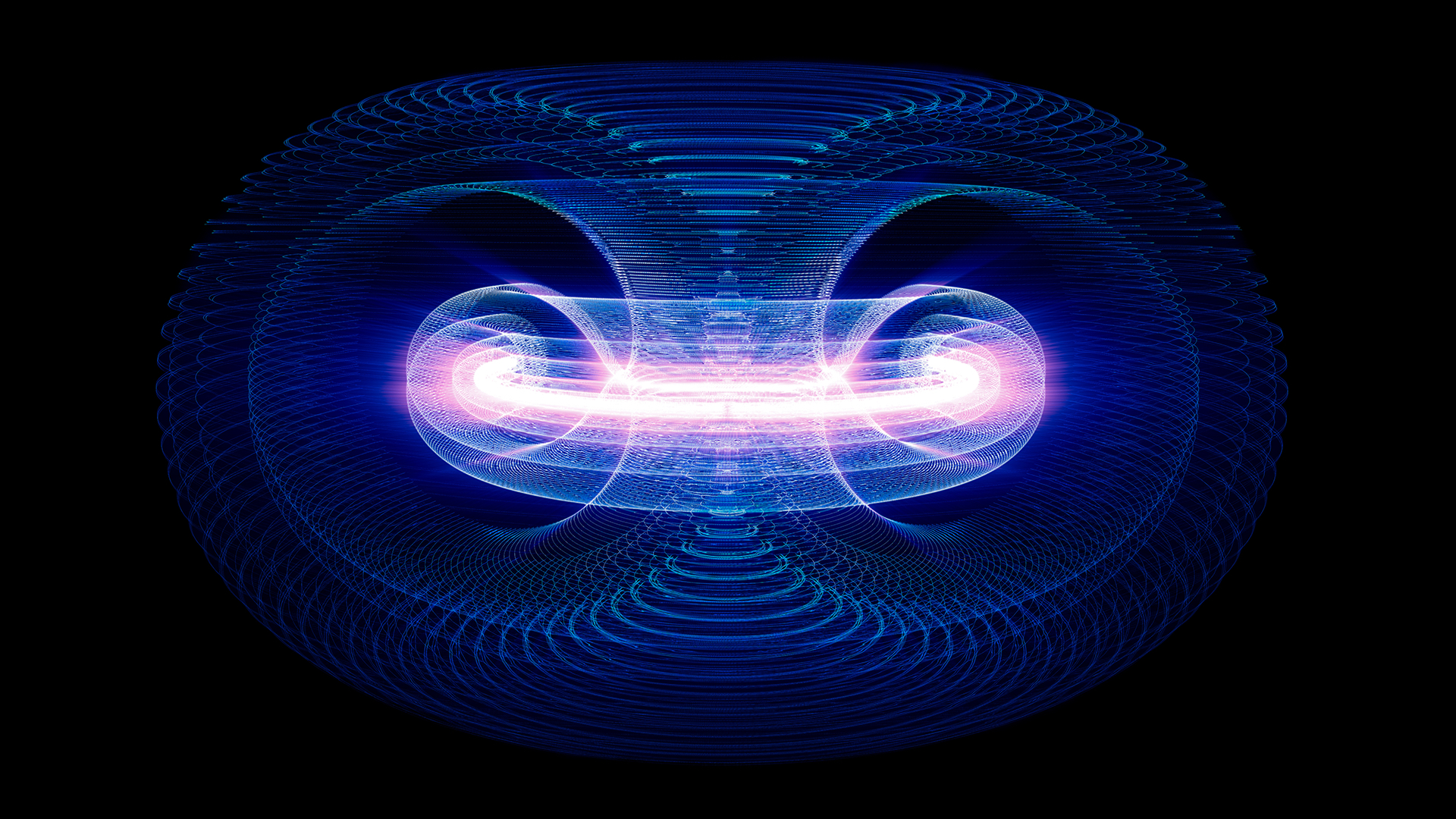The three-year PPPL awards — with several more pending — cover research to speed the development of both doughnut-shaped tokamak fusion facilities and compact cored apple-shaped spherical tokamaks akin to the flagship National Spherical Tokamak Experiment-Upgrade (NSTX-U) at the DOE national Laboratory. The work is managed in the new Tokamak Experimental Sciences Department led by Rajesh Maingi and Joseph Snipes and may be subject to revision in future years as federal budgets evolve.
Fusion combines light elements in the form of plasma — the hot, charged state of matter composed of free electrons and atomic nuclei, or ions, that makes up 99 percent of the visible universe — to release vast amounts of energy. PPPL and scientists around the world are seeking to reproduce and control fusion on Earth for a virtually inexhaustible supply of safe and clean power to generate electricity.
The PPPL awards are part of the $47 million of DOE funding to speed closing the remaining science and technology gaps to enable the construction of a power plant to produce net electricity from fusion at low capital cost. “We must continue to provide innovative solutions to the most urgent challenges facing fusion energy and advance the state of the art across fusion and plasma sciences,” said Harriet Kung, acting associate director of science for fusion energy sciences. The $47 million, she said, will empower “moving us closer to fusion energy as a clean and abundant energy source.”
Following are the three-year PPPL awards:
Collaborative Research on International and Domestic Spherical Tokamaks
Exploring Spherical Tokamak Physics on the SMART Facility in Spain
This award totals $5.1 million for work led by Mario Podestà, a PPPL physicist, to
investigate a solution to the challenge of confining the extreme heat from the exhaust of fusion reactions. This is to be done while mitigating the effects of bursts of heat exhaust that can strike and damage the walls of spherical tokamaks such as the SMall Aspect Ratio Tokamak (SMART) under construction at the University of Seville, Spain.
A key PPPL objective will be to help explore the dependence of good plasma confinement on innovative plasma shapes in SMART and to compare that to the confinement dependence on larger tokamaks.
This new collaboration is particularly timely given the growing number of public and private fusion programs focusing on the spherical configuration and is part of a broader set of collaborations between PPPL and other spherical tokamaks coordinated by Jack Berkery, PPPL physicist.
“This work should increase the flexibility of spherical tokamak operations,” Podesta said. “It will broaden the range of options for long-term use as a pilot plant.”
3D Response and Control on the MAST-U Spherical Tokamak
A three-year renewal totaling $193,000 for work by Stefano Munaretto, a PPPL physicist, focuses on how magnetic fields affect the plasma in the United Kingdom’s Mega-Amp Spherical Tokamak-Upgrade (MAST-U). This project, led by physicist Yueqiang Liu of General Atomics, will experiment with differently shaped 3D magnetic fields to see how each affects plasma behavior.
A key aim will be to determine how well different fields suppress bursts of heat called edge-localized modes (ELMs) that can interrupt fusion reactions and impair the walls of a facility. The work will produce expertise in the use of 3D fields to control ELMs that might arise in ITER, the large international fusion facility under construction in the south of France, and in the design of a U.S. fusion pilot plant.
“This work is based on the successful use of 3D fields by the DIII-D National Fusion Facility to measure and control disruptive ELMs,” Munaretto said. “It should produce crucial knowledge for handling this frequent operating problem.”
Rapid 3D Heat Predictions for Spherical and High-Magnetic-Field Tokamaks
Another award for Munaretto totaling $1.5 million to collaborate with Oak Ridge National Laboratory (ORNL) will be used to contribute to developing a way to mitigate extreme plasma heat fluxes in the innovative Soonest/Smallest Private-Funded Affordable Robust Compact (SPARC) tokamak. The task will be to improve understanding of the heat that strikes and can damage plasma facing components in the high-field SPARC facility being developed by Commonwealth Fusion Systems, a spinoff from the Massachusetts Institute of Technology (MIT).
Improved understanding and predictive ability of the 3D fluxes generated by 3D magnetic fields will produce models that can be applied to spherical tokamaks and the design of a fusion power plant. The task is divided into two main areas: expanding the capabilities of the code that predicts fluxes and studying how the plasma responds to the 3D magnetic field that produces the fluxes that strike SPARC components.
“The goal is to enhance the capability of spherical and high-field tokamaks,” Munaretto said. “This collaboration could deliver a breakthrough in meeting the challenge.”
Collaborative Research on International Tokamaks
Realization of a Tokamak-Based Fusion Power Plant
A $1-million renewal of research for Zhen Sun, PPPL physicist, continues his collaboration in a key multi-laboratory project. His work is central to the effort to adapt high-performance scenarios from the General Atomics DIII-D National Fusion Facility to the Experimental Advanced Superconducting Tokamak (EAST) in Hefei, China. The project aims to demonstrate long-pulse and disruption-free plasmas while handling plasma exhaust and plasma-wall interaction issues.
Six U.S. institutions led by General Atomics are carrying out this research together with EAST scientists who will participate in U.S. experiments and support U.S. operations. The project enlists the ability of EAST to help the U.S. secure a central role in the operation of ITER, the international experiment under construction in the south of France, and helps EAST accelerate its own program.
The work of Sun focuses on testing the injection of powders such as boron into experiments to improve control of their long-term, high-performance operation. Specific tasks will range from suppressing heat bursts called edge localized modes (ELMs) that can damage the internal walls of a facility to integrating injections into extended high magnetic field plasma performance.
“Suppressing ELMs and integrating impurity powder is vital for prolonging high-performance fusion operations,” Sun said. “Our research and our colleague’s work are helping to pave the way to a fusion pilot plant.”
Long-Pulse ITER Scenarios and Control on KSTAR
Two new awards totaling $1.75 million for Erik Gilson, PPPL physicist, for a project led by General Atomics will investigate tools that can help sustain high-performance plasma during operations on the international fusion experiment ITER, which is under construction in the south of France to demonstrate the practicality of fusion energy. ITER is scheduled to produce a sustained burning plasma of 500 megawatts for 6-to-10 minutes in the 2030s.
“We are thrilled to be a part of two exciting and hopefully impactful research projects,” Gilson said of the awards, which involve experimenting with droppers that inject powders such as boron into the Korea Superconducting Tokamak Advanced Research (KSTAR) facility. “We’ve seen powder droppers have really cool, interesting effects on KSTAR plasmas but now it will be used as part of these larger research projects.”
Researchers in one project will use computer modeling, automated control systems and powder injection to control the power, radiation temperature and density of the plasma to avoid disruptions and optimize performance as a test for baseline scenarios planned for ITER.
The National Academy of Sciences, Engineering and Medicine has identified ITER as crucial for the next step in the development of fusion energy for a fusion energy pilot plant. “The powder dropper can be a great tool for studying ITER-relevant and reactor-relevant scenarios,” Gilson said. “This award enables us to explore maintaining high performance on ITER.”
Development of Divertor Plasma Detachment Control Systems on the KSTAR Tokamak
A related award led by General Atomics with Gilson as a co-investigator takes up the major challenge of how to control the high heat and disruptions during fusion experiments that can damage the components of tokamaks. Researchers will study the use of a powder dropper as a control tool on KSTAR as a model for ITER.
The collaboration will focus on whether using the dropper to inject substances such as boron or boron nitride into the plasma can help control the power, density and temperature of the plasma, which is heated to temperatures hotter than the sun. The injection could help prevent damage to the walls and the divertor system at the bottom of the device that acts as an exhaust system.
The goal is to use a technique called “divertor detachment” to convert the hot plasma into a neutral gas before it strikes the divertor. This technique must be measured and analyzed through an automated control system because too much injection can disrupt the plasma and reduce the confinement. “The powder dropper is a useful tool to help protect the divertor,” Gilson said. “We’re looking forward to seeing the dropper used in these new contexts.”
Optimization and Control for Integrated 3D Edge Long-Pulse Plasma
Jong-Kyu Park, a PPPL physicist, was awarded $2 million to lead multi-institutional efforts to improve the use of external nonaxisymmetric (3D) magnetic fields to keep plasma hot and stable in doughnut-shaped fusion facilities known as tokamaks. The research will focus on South Korea’s Superconducting Tokamak Advanced Research (KSTAR) tokamak. Nonaxisymmetric fields help to confine plasma and do not flow symmetrically around the tokamak axis.
The project leverages the progress of previous research into the integrated use of 3D magnetic fields to stabilize the edge of fusion plasma instabilities while improving core performance of the plasma. The project consists of three parts:
1) Develop a database from fusion facilities around the world, including KSTAR; Germany’s Axially Symmetric Divertor Experiment-Upgrade (AUG); and China’s Experimental Advanced Superconducting Tokamak (EAST). The research team will utilize that database to validate simulations and extend predictive capabilities on 3D tokamak plasmas.
2) Place these improved programs, or algorithms, into TRANSP, a leading plasma-modeling program developed at PPPL. This new version of TRANSP will be used to optimize 3D tokamak scenarios in KSTAR by predicting the flow of heat and particles in long-pulse tokamaks under 3D fields and identifying optimal ways to suppress plasma bursts known as edge-localized modes (ELMs) that could damage fusion facilities. Included is application of transport simulations to incorporate predictions of fast ion losses or plasma turbulence into the optimization.
3) The third part will apply the updated predictive tools and TRANSP scenario optimizations with real-time control of 3D fields to create plasmas in KSTAR that last more than 100 seconds with no ELMs.
Evaluation of Tungsten in a Long-Pulsed Tokamak
Ahmed Diallo, principal research physicist at PPPL, was awarded $1.2 million to lead an investigation of the use of tungsten, a hard material used in lightbulbs and rocket nozzles, in the WEST — formerly Tore Supra — tokamak in Cadarache, France. The exploration will study the interaction between the material coating the components inside the tokamak and the ultra-hot plasma within.
Robert Lunsford, a PPPL research physicist, will lead the project while Diallo serves as program director for the DOE’s Advanced Research Projects Agency-Energy (ARPA-E). The funding will focus on the application of coatings made of tungsten to protect components from the plasma.
Specifically, the team will explore how the plasma might change when the tungsten coating erodes into it. The team will also study how the plasma might in turn alter the tungsten. This information could help researchers stabilize fusion reactions in future fusion facilities like ITER, the multinational tokamak being built in Cadarache to test the practicality of fusion energy. The findings could also affect the design of fusion power plants to be built to generate electricity.
###
PPPL, on Princeton University’s Forrestal Campus in Plainsboro, N.J., is devoted to creating new knowledge about the physics of plasmas — ultra-hot, charged gases — and to developing practical solutions for the creation of fusion energy. The Laboratory is managed by the University for the U.S. Department of Energy’s Office of Science, which is the single largest supporter of basic research in the physical sciences in the United States and is working to address some of the most pressing challenges of our time. For more information, visit https://energy.gov/science




